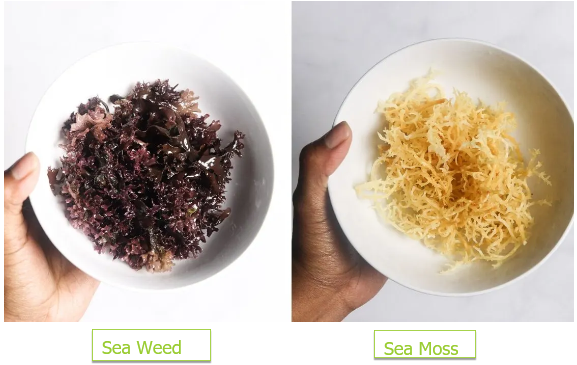Sea moss and seaweed are both marine plants, but they have distinct differences in terms of their appearance, nutritional profile, uses, and other characteristics. Here are some of the primary differences between sea moss and seaweed:
- Types and Varieties:
- Sea Moss, also known as Irish Moss, is a specific type of red algae belonging to the Chondrus crispus species.
- Seaweed: This is a general term that encompasses various types of marine plants and algae, including green, brown, and red varieties. Examples include kelp, nori, and wakame.
- Appearance:
- Sea Moss: It is often found in a stringy, almost gelatinous form. When dried, it appears yellowish or purple.
- Seaweed: The appearance varies widely depending on the type. For instance, nori (used in sushi) is thin and sheet-like, while kelp can be long and leafy.
- Nutritional Profile:
- Sea Moss: It is known for its rich mineral content, especially iodine. It also contains vitamins, amino acids, and antioxidants.
- Seaweed: The nutritional content varies by type. Generally, seaweeds are a good source of iodine, vitamins, minerals, and fiber. Some types, like kelp, are also rich in protein.
- Uses:
- Sea Moss: Often used as a thickening agent in foods due to its gelatinous nature. It’s also popular in natural health communities for its perceived health benefits and is used in smoothies, supplements, and skincare products.
- Seaweed: Used in a variety of culinary dishes, especially in Asian cuisines. Nori is used for sushi rolls, wakame in miso soup, and kelp can be eaten as noodles or used in salads.
- Taste and Texture:
- Sea Moss: It has a mild taste and a gelatinous texture when soaked and prepared.
- Seaweed: The taste can range from salty to umami, depending on the type. The texture can be crispy (like dried nori) or chewy (like soaked wakame).
- Cultivation and Harvesting:
- Sea Moss: Often wild-harvested from the ocean, but there are also cultivation efforts to meet the growing demand.
- Seaweed: Can be wild-harvested or cultivated in seaweed farms. The method of cultivation and harvesting varies depending on the type.
- Health Benefits:
- Sea Moss: Believed to support respiratory health, improve digestion, and boost the immune system, among other benefits.
- Seaweed: Offers a range of health benefits, including supporting thyroid function (due to its iodine content), improving gut health, and providing antioxidants.
It’s important to note that while both sea moss and seaweed offer health benefits, they should be consumed in moderation. Excessive intake, especially of iodine-rich varieties, can lead to health issues. Always consult with a healthcare professional before adding new supplements or foods to your diet.

